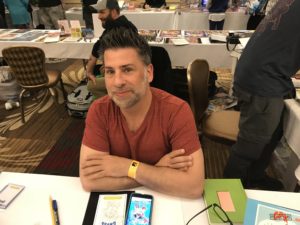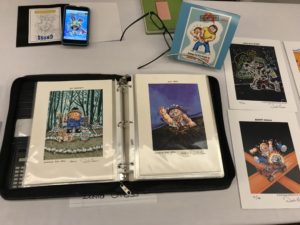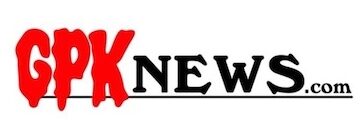 Along with Joe Simko and Brent Engstrom, David Gross is one of the main artists behind the current Garbage Pail Kids sets. He’s done dozens of GPKs to date, with his biggest contribution set to happen in the 2018S2 set. David is popular on Facebook with collectors for sharing not only the final paintings once release, but also the rejected concepts Topps doesn’t use. I sat down with David at Gross Card Con in Las Vegas. We talked about the lifecycle of a GPK, his thoughts on digital vs. traditional painting, and some changes to GPK he’s lobbied Topps for.
Along with Joe Simko and Brent Engstrom, David Gross is one of the main artists behind the current Garbage Pail Kids sets. He’s done dozens of GPKs to date, with his biggest contribution set to happen in the 2018S2 set. David is popular on Facebook with collectors for sharing not only the final paintings once release, but also the rejected concepts Topps doesn’t use. I sat down with David at Gross Card Con in Las Vegas. We talked about the lifecycle of a GPK, his thoughts on digital vs. traditional painting, and some changes to GPK he’s lobbied Topps for.
GPKNews – I think more than ever in 2017 GPK collectors have really gravitated to your work. I know you are a Wacky Packages guy, but how much fun are you having working on the GPK brand?
David Gross – I love working on the Garbage Pail Kids, I’m actually enjoying working on them little more than the Wacky’s lately. I’ve been doing probably 2 to 1 Garbage Pail Kids at this point.
GPKNews – You continue to post your rejected concepts on Facebook with each release. GPK collectors continue to get a kick out of the ones Topps decides not to use. What’s more fun for you, coming up with the concepts and the rough, or the final paining of the card and seeing your concept in its final form?
DG – I like both of them. I’d probably say painting them. I stay up all night and talk to Brent, we just paint all night.
GPKNews – How much time on average does it take for a GPK to come to life? From the initial concept, to the pencil rough, color rough, back and forth with the Art Director, and then the final painting? How much time do you spend on each retail card?
 DG – I start with a thumbnail sketch. I just start drawing out a general idea until I get the right pose. Then I probably spend about an hour sketching it out in pencil. Then another hour or so on the final pencil. Then paintings can run anywhere from 4 hours for the rushed to get it done overnight online ones, to if I have time, I’ll spend two days on some. The halloween set we recently did I spent almost 3 days on every painting, because I had time on that one. It was a lot of fun to be able to do that again.
DG – I start with a thumbnail sketch. I just start drawing out a general idea until I get the right pose. Then I probably spend about an hour sketching it out in pencil. Then another hour or so on the final pencil. Then paintings can run anywhere from 4 hours for the rushed to get it done overnight online ones, to if I have time, I’ll spend two days on some. The halloween set we recently did I spent almost 3 days on every painting, because I had time on that one. It was a lot of fun to be able to do that again.
GPKNews – I know you are a big music guy, so you had a lot of fun working on Battle of the Bands. I think the work you did on the Halloween set might have been your best last year? What set did you enjoy most working on in the last year?
DG – Easily the Halloween set. Having the time and the subject matter was my favorite.
GPKNews – I know you work a lot behind the scenes with the people at Topps to give the GPK collector a voice. Is it hard to get Topps to understand what the longtime collector wants?
DG – They will listen but they also have the bottom line, so its been difficult to get them to do what collectors feel they should be doing . With Colin for example, he has a tough job because he has to answer to people above him. So he has to make their demands work, collectors demands work, and artists demands work. Its a stressful job. We try our best to do what we can. I think there will be some more changes coming up. I’ve been pushing a lot of stuff and hopefully they will come through.
GPKNews – In the second half of last year I think there’s been some progress towards what collectors are looking for. Especially in the concepts and art, and a little in set structure. Its baby steps, but steps nonetheless. Do you sense some of the things GPK collectors ask for are starting to become a reality?
DG – First thing I’m hoping we get backs, back. I think thats the number one thing, if I’m reading what collectors want the most. I think the Classic set was a good idea that they dropped the ball on a couple things on that by not having backs on there and the arrow and everything else on there that everyone wanted. I think they did learn a lesson on there from the Wacky Packages Old School set. That one sold out in three days. I think if they do another Classic set, they will look at that and try to fix some of the problems.
 GPKNews – I’ve asked a few artists this, and wanted to get your thoughts. Right now retail GPKs still must be painted, but Colin has allowed some digital work in the online sets. What thoughts do you have, specifically when it comes to GPK art, on creating cards digitally vs. the old fashioned way?
GPKNews – I’ve asked a few artists this, and wanted to get your thoughts. Right now retail GPKs still must be painted, but Colin has allowed some digital work in the online sets. What thoughts do you have, specifically when it comes to GPK art, on creating cards digitally vs. the old fashioned way?
DG – When I first started doing it, the first things I sent to Topps were digital. That was way back in 2003 or 2004. First thing they said to me was can you paint them, I said yeah of course. So I sent in samples of them painted, and that’s how I got the job doing Wacky’s. I’ve always painted everything, except occasionally on the Wacky’s I do some of the lettering digitally. For the most part I even paint all the lettering on those. I don’t really have an interest in the digital artwork, and never do it myself.
GPKNews – Do you think we will see the day where the main way of creating GPKs or the like are done digitally?
DG – I hope painting continues to rule the day. I don’t think people will want all digital paintings. If you don’t get the textures right they look weird. I’ve seen some stuff where the figures look like the backgrounds. You need to be able to differentiate all the textures. I just think the hand painted quality is much nicer.
GPKNews – Finally this is your second GCC here in Vegas. How does this one compare to the first? How has the fan interaction been?
DG – Great, this has been much better than the first one. The layout of the room is much easier to talk to people. I get to talk to the other artists, which I didn’t get to do last time all lined up in one long row. I have people on both sides of me in front and back, its been great. Last year I brought the rejected books, I started drawing them and I never looked up in two days This time I took some orders, draw them at night, bring them back the next morning so I’ve been able to have a lot more interaction this time around.

Great interview as always!
Thanks for doing this. Love the questions and reading their responses.